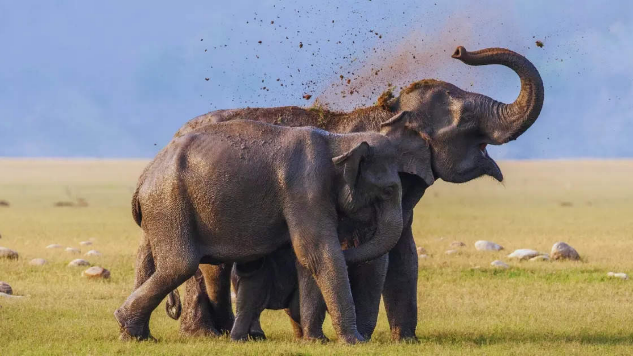
Why In News:
Because of ecological overcrowding and conflict between humans and wildlife, Zimbabwe has authorized the slaughter of fifty elephants in the Save Valley Conservancy.

Elephants at Risk: Zimbabwe’s Controversial Culling Operation
What Is Happening?
Zimbabwe’s wildlife authority (ZimParks) has launched a culling operation targeting elephants in the Save Valley Conservancy, one of the country’s largest private wildlife reserves. With 2,550 elephants crammed into a space built to support just 800, the reserve faces a critical ecological imbalance.
Why the Culling?
The primary motivation is overpopulation, which has led to a cascade of environmental and social issues:
- Severe biodiversity stress due to elephants uprooting vegetation and damaging habitats.
- Frequent human-wildlife conflict, as elephants wander into villages in search of scarce food and water.
- Climate stress, including prolonged droughts, has further reduced natural resources.
- Relocation attempts have failed—only 200 elephants moved over five years, making it an inadequate solution.
The Debate: To Cull or Not to Cull?
The move has sparked heated debate in conservation circles, with strong arguments on both sides.
🔹 Arguments For Culling
- Ecological Balance: Helps control overpopulation and prevents damage to fragile ecosystems.
- Public Safety: Reduces human-elephant conflict, potentially saving human lives.
- Resource Utilization: Meat and byproducts can benefit local communities.
- Scientific Backing: Aligns with certain wildlife management frameworks.
- Habitat Protection: Prevents further degradation and loss of other species.
🔹 Arguments Against Culling
- Animal Ethics: Seen as a violation of animal rights and an attack on intelligent, social creatures.
- Tourism Impact: Zimbabwe risks damaging its image as a “Big Five” safari destination.
- Sustainable Alternatives Exist: Non-lethal options like sterilization or relocation remain underutilized.
- Dangerous Precedent: May normalize lethal conservation tactics.
- Poaching Risk: Legal culling could be misused as a cover for illegal hunting.
A Complex Conservation Challenge
Zimbabwe’s elephant crisis reflects the tension between conservation science and animal welfare ethics, particularly in regions facing climate change, population pressures, and limited resources.
As Africa’s iconic species face habitat loss and shifting public sentiments, policymakers must find a balance between preserving biodiversity and respecting life—human and animal alike.
52nd G7 Summit

Why In News:
On invitation from the prime minister of Canada, the prime minister of India will attend the 52nd G7 Summit in Kananaskis, Canada, from June 15–17, 2025.
Since 2019, India has been a special invitee to the G7.
What is the G7?
The Group of Seven (G7) is an informal intergovernmental forum comprising the seven richest liberal democracies in the world. It serves as a high-level platform for coordinating responses to global economic and geopolitical challenges. Unlike formal international organizations, the G7 is not treaty-based and lacks a permanent secretariat, which makes its operations more flexible, yet equally influential.
Origins and Formation
The G7 was born in 1975 amidst the backdrop of the global oil crisis, when the world’s leading industrialized economies recognized the need for coordinated macroeconomic dialogue.
Initially formed as the Group of Six (France, Germany, Italy, Japan, the UK, and the USA), it became the G7 after Canada joined in 1976.
The European Union also participates in G7 summits but is not considered a full member.
Current Members
- United States
- United Kingdom
- France
- Germany
- Italy
- Japan
- Canada
- European Union (as a permanent invitee)
Historical Evolution of G7
- 1970s: Focused on energy security and macroeconomic stability following the oil embargo and recession.
- 1980s: Agenda expanded to include geopolitical issues, such as nuclear arms control and human rights.
- 1990s–2000s: Broadened scope to address poverty reduction, debt relief, and climate change, reflecting a more global outlook.
- 1998–2014: With Russia’s inclusion, the group became the G8, but it reverted to G7 after Russia was suspended post-Crimea annexation in 2014, reaffirming the bloc’s commitment to democratic governance.
Key Functions of the G7
1. Macroeconomic Coordination
G7 countries collaborate to maintain global economic stability, combat inflation, and ensure sound fiscal management. The group often issues joint statements that influence currency markets, interest rates, and trade policies.
2. Addressing Global Crises
From the COVID-19 pandemic to climate change, AI governance, and cybersecurity threats, the G7 plays a vital role in shaping global responses and driving multilateral cooperation.
3. Championing Democracy and Development
G7 nations advocate for liberal democratic values, human rights, gender equality, and sustainable development, often influencing the policy agenda of international organizations like the UN, World Bank, and IMF.
4. Policy Signalling and Donor Alignment
As global trendsetters, G7 decisions often serve as a signal to global markets and institutions. They also coordinate aid and development policies toward low- and middle-income countries.
Why the G7 Still Matters
Despite criticisms of being exclusive or outdated, the G7 remains a vital force in global governance. Its shared values, economic influence (collectively accounting for ~40% of global GDP), and ability to act quickly without bureaucratic constraints make it an indispensable platform in an increasingly fragmented world.






